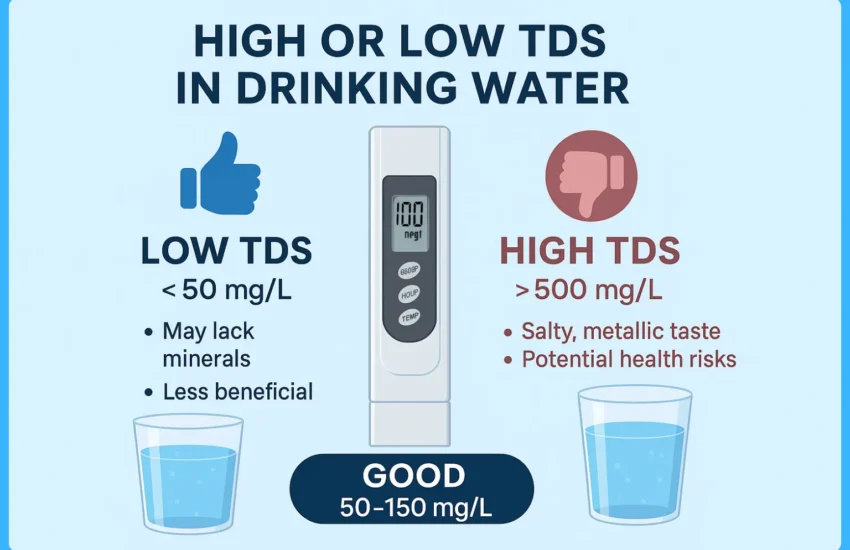Everyone of us considers and wants purity, odour-free free and good taste in our water for health and hygiene. One important factor that often gets overlooked is the level of TDS in drinking water. Total Dissolved Solids, or TDS, is a technical phrase that helps you to make sure the water you consume is really safe and healthy.
TDS in drinkable water? How much TDS in water is good for health?
TDS is the total dissolved solids in water including minerals, salts, and organic matter. This may consist of minerals like calcium, magnesium, and potassium, as well as elements such as chlorides, sulfates, and occasionally even small amounts of heavy metals. Although some of these minerals are vital for our bodies, too much can compromise water’s flavor and safety.
Good health depends on how much TDS is in drinking water.
How much TDS in water is good for health promotes health is a typical and crucial inquiry.
The BIS (Bureau of Indian Standards) says that the TDS level of 500g/L is the maximum in drinking water that we can have. The best range though is generally thought to be:
- 50–150 mg/L: Fantastic (great taste, enough minerals)
- 150–300 mg/L: Good (fit for drinking).
- 300–500 mg/L: Good (acceptable but could affect taste)
- Above 500 mg/L: Not advised for long-term use.
Water with exceptionally low TDS levels—specifically less than 50 mg/L—may need fundamental minerals that our body needs, such as calcium and magnesium. These minerals play a pivotal part in keeping up bone wellbeing, muscle work, and in general metabolic adjust. When these are lost from your day-to-day water admissions, it might not be as advantageous, indeed on the off chance that the water looks clean and tastes fine.
On the other side, High TDS level in water can be salty and metallic in taste. It may moreover feel heavier or denser once you drink it. Delayed utilization of such water, particularly on the off chance that it contains harmful substances like nitrates, arsenic, or overabundance sodium, can lead to potential wellbeing dangers. It’s continuously a great thought to check and keep up an adjusted TDS level in your drinking water for ideal wellbeing and taste.
What Causes Water’s High or Low TDS?
TDS levels in water depend on the source it comes from—like streams, groundwater, or treated civil supply.
Tall TDS can be caused by normal minerals, mechanical squander, or ancient plumbing frameworks.
TDS as a rule implies the water is exceedingly filtered or comes from sources with less broken down solids.
- Typical causes of high TDS:
- natural mineral deposits in the ground
- Sewage dumping and industrial waste
- Farms runoff including pesticides and fertilizers
- Common factors of low TDS:
- Distilled water or rainwater
- Too much purification (e. g. RO water lacking mineralizers)
TDS in Water Purifier: Why It Matters
If you ‘re using a water purifier, odds are it’s an RO system great for removing impurities but also stripping away useful minerals. This is precisely when the water filter TDS becomes critical.
RO purifiers of today recently feature:
TDS controllers: Maintain and adjust critical minerals.
Mineralizers: Post-filtration reintroduces useful elements.
Smart monitoring: display current TDS levels.
Purchase a purifier that lets you change or control TDS level; not all TDS is bad!
TDS in Water at Home: How to Check It Like a Pro!
Wondering if your drinking water is actually safe?
Let’s make it simple for you!
All you need is a digital TDS meter — a handy little device that checks the purity of your water in seconds.
Step 1: Fill a clean glass with water
Step 2: Dip the TDS meter into the glass of water.
Step 3: Wait a few seconds… and boom!
Your screen will display the TDS level in PPM (parts per million).
In between 50-150 ppm is considered as a great ideal drinking water.
Conclusion
Consult a water specialist or think about improving your purifier if your water TDS is always high or low.Water with too much TDS might contain pollutants. The answer lies in balance. The correct TDS is not simply a number; it also indicates healthy, hydrating water. Have queries concerning your purifier or how much TDS in water is healthy for health? We are here to help you sip safely; please drop comments.
To Know More About Us Visit:- Effluent Wastewater Treatment Plant
Frequently Asked Questions (FAQs)
- What TDS should drinking water ideally have?
BIS guidelines indicate that anything up to 500 mg/L is still safe; the perfect TDS range is 50–150 mg/L.
- Does high TDS in drinking water pose any health risks?
If not properly filtered, it might contain dangerous elements like nitrates or heavy metals and can give a salty taste.
- Is highly low TDS RO water toxic?
Water under 50 mg/L TDS might not have vital minerals, therefore it is less advantageous for extended consumption.
- How am I able to determine whether my purifier is adequately controlling TDS?
See whether your RO purifier has a mineralizer or TDS controller. Regular testing of water output can also be done using a digital meter.

